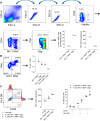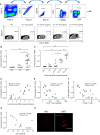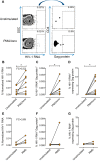A Novel Single-Cell FISH-Flow Assay Identifies Effector Memory CD4+ T cells as a Major Niche for HIV-1 Transcription in HIV-Infected Patients
- PMID: 28698276
- PMCID: PMC5513707
- DOI: 10.1128/mBio.00876-17
A Novel Single-Cell FISH-Flow Assay Identifies Effector Memory CD4+ T cells as a Major Niche for HIV-1 Transcription in HIV-Infected Patients
Abstract
Cells that actively transcribe HIV-1 have been defined as the "active viral reservoir" in HIV-infected individuals. However, important technical limitations have precluded the characterization of this specific viral reservoir during both treated and untreated HIV-1 infections. Here, we used a novel single-cell RNA fluorescence in situ hybridization-flow cytometry (FISH-flow) assay that requires only 15 million unfractionated peripheral blood mononuclear cells (PBMCs) to characterize the specific cell subpopulations that transcribe HIV RNA in different subsets of CD4+ T cells. In samples from treated and untreated HIV-infected patients, effector memory CD4+ T cells were the main cell population supporting HIV RNA transcription. The number of cells expressing HIV correlated with the plasma viral load, intracellular HIV RNA, and proviral DNA quantified by conventional methods and inversely correlated with the CD4+ T cell count and the CD4/CD8 ratio. We also found that after ex vivo infection of unstimulated PBMCs, HIV-infected T cells upregulated the expression of CD32. In addition, this new methodology detected increased numbers of primary cells expressing viral transcripts and proteins after ex vivo viral reactivation with latency reversal agents. This RNA FISH-flow technique allows the identification of the specific cell subpopulations that support viral transcription in HIV-1-infected individuals and has the potential to provide important information on the mechanisms of viral pathogenesis, HIV persistence, and viral reactivation.IMPORTANCE Persons infected with HIV-1 contain several cellular viral reservoirs that preclude the complete eradication of the viral infection. Using a novel methodology, we identified effector memory CD4+ T cells, immune cells preferentially located in inflamed tissues with potent activity against pathogens, as the main cells encompassing the transcriptionally active HIV-1 reservoir in patients on antiretroviral therapy. Importantly, the identification of such cells provides us with an important target for new therapies designed to target the hidden virus and thus to eliminate the virus from the human body. In addition, because of its ability to identify cells forming part of the viral reservoir, the assay used in this study represents an important new tool in the field of HIV pathogenesis and viral persistence.
Keywords: human immunodeficiency virus; viral persistence; viral reactivation; viral reservoirs.
Copyright © 2017 Grau-Expósito et al.
Figures





Similar articles
-
Atlas of the HIV-1 Reservoir in Peripheral CD4 T Cells of Individuals on Successful Antiretroviral Therapy.mBio. 2021 Dec 21;12(6):e0307821. doi: 10.1128/mBio.03078-21. Epub 2021 Nov 30. mBio. 2021. PMID: 34844430 Free PMC article.
-
A Novel Toll-Like Receptor 9 Agonist, MGN1703, Enhances HIV-1 Transcription and NK Cell-Mediated Inhibition of HIV-1-Infected Autologous CD4+ T Cells.J Virol. 2016 Apr 14;90(9):4441-4453. doi: 10.1128/JVI.00222-16. Print 2016 May. J Virol. 2016. PMID: 26889036 Free PMC article.
-
Ultrasensitive HIV-1 p24 Assay Detects Single Infected Cells and Differences in Reservoir Induction by Latency Reversal Agents.J Virol. 2017 Feb 28;91(6):e02296-16. doi: 10.1128/JVI.02296-16. Print 2017 Mar 15. J Virol. 2017. PMID: 28077644 Free PMC article.
-
RNA flow cytometric FISH for investigations into HIV immunology, vaccination and cure strategies.AIDS Res Ther. 2017 Sep 12;14(1):40. doi: 10.1186/s12981-017-0171-x. AIDS Res Ther. 2017. PMID: 28893281 Free PMC article. Review.
-
Reservoirs for HIV-1: mechanisms for viral persistence in the presence of antiviral immune responses and antiretroviral therapy.Annu Rev Immunol. 2000;18:665-708. doi: 10.1146/annurev.immunol.18.1.665. Annu Rev Immunol. 2000. PMID: 10837072 Review.
Cited by
-
Improved killing of HIV-infected cells using three neutralizing and non-neutralizing antibodies.J Clin Invest. 2020 Oct 1;130(10):5157-5170. doi: 10.1172/JCI135557. J Clin Invest. 2020. PMID: 32584790 Free PMC article.
-
Catchet-MS identifies IKZF1-targeting thalidomide analogues as novel HIV-1 latency reversal agents.Nucleic Acids Res. 2022 Jun 10;50(10):5577-5598. doi: 10.1093/nar/gkac407. Nucleic Acids Res. 2022. PMID: 35640596 Free PMC article.
-
HIV persistence in subsets of CD4+ T cells: 50 shades of reservoirs.Semin Immunol. 2021 Jan;51:101438. doi: 10.1016/j.smim.2020.101438. Epub 2020 Nov 30. Semin Immunol. 2021. PMID: 33272901 Free PMC article. Review.
-
Phenotyping Viral Reservoirs to Reveal HIV-1 Hiding Places.Curr HIV/AIDS Rep. 2025 Feb 4;22(1):15. doi: 10.1007/s11904-025-00723-6. Curr HIV/AIDS Rep. 2025. PMID: 39903363 Free PMC article. Review.
-
Identification of HIV-reservoir cells with reduced susceptibility to antibody-dependent immune response.Elife. 2022 May 26;11:e78294. doi: 10.7554/eLife.78294. Elife. 2022. PMID: 35616530 Free PMC article.
References
-
- Palmer S, Maldarelli F, Wiegand A, Bernstein B, Hanna GJ, Brun SC, Kempf DJ, Mellors JW, Coffin JM, King MS. 2008. Low-level viremia persists for at least 7 years in patients on suppressive antiretroviral therapy. Proc Natl Acad Sci U S A 105:3879–3884. doi:10.1073/pnas.0800050105. - DOI - PMC - PubMed
-
- Chun TW, Justement JS, Murray D, Hallahan CW, Maenza J, Collier AC, Sheth PM, Kaul R, Ostrowski M, Moir S, Kovacs C, Fauci AS. 2010. Rebound of plasma viremia following cessation of antiretroviral therapy despite profoundly low levels of HIV reservoir: implications for eradication. AIDS 24:2803–2808. doi:10.1097/QAD.0b013e328340a239. - DOI - PMC - PubMed
Publication types
MeSH terms
Substances
Grants and funding
LinkOut - more resources
Full Text Sources
Other Literature Sources
Medical
Research Materials
Miscellaneous

